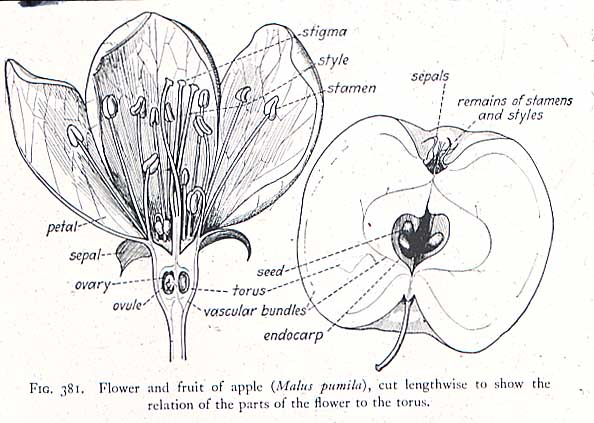Winter dormancy of woody plants is based on their ability to track photoperiod, air temperature and soil temperature. Once in a dormant state, the plant goes on to develop cold resistance, also referred to as "cold-hardening" or "cold-hardiness". Dormancy happens before the cold-hardening process starts, usually in about September for woody plants. The first stage of dormancy is called "endodormancy" – plants stop growing so that they can reconfigure their gene expression towards the acquisition of cold tolerance. During endodormancy, internal signals and processes within the plant prevent growth, even if the plant is returned to growth-promoting external conditions. In other words, during endodormancy buds simply can't grow. This prevents the initiation of new shoot growth from buds in autumn, when the environment can rapidly fluctuate between growth-promoting and non-promoting conditions – that would be a waste of precious energy for the plant.
Cold-hardening* refers to environmentally- and hormonally-regulated changes in gene expression that lead to changes in metabolism and cellular functioning to protect cells from damage due to dehydration and freezing. It occurs in two stages over a period of weeks to months. Stage 1 occurs when temperatures are between 10 - 20 °C (50 – 68 °F) and includes a shift on gene expression towards storage of reserve carbohydrates and lipids. Stage 2 is promoted by colder temperatures and involves the accumulation of cryoprotectant substances (natural "antifreeze"), as well as changes in membrane lipids and structural changes in bud anatomy. Because cold-hardening requires energy, a plant may not be able to become fully cold-hardened if it is diseased or stressed such that there are low amounts of reserve carbohydrates.
Bud dormancy is only broken by exposure to cold temperatures – i.e. by a period of chilling. The plant senses "chill" (temperatures below "biological zero" 41 °F; 5 °C). Although freezing is not required, freezing temperatures during endodormancy can break dormancy faster. Likewise, intermittent warm days during endodormancy delay dormancy release. Between 1000 and 2000 hours of chilling are required for most woody plants in temperate zones, varying by species. A combination of photoperiod (increasing day length) and adequate chilling leads to dormancy release. The buds now enter a period referred to as "ecodormancy" – meaning that growth is arrested by environmental conditions that are not conducive to growth. As soon as conditions become favorable, growth can occur.
The overall process goes something like this:
• The plant needs to form buds so that it can generate vegetative growth (leaves) next year, because leaves are where photosynthesis occurs – i.e. where food is made by the plant. Setting buds requires the plant to use energy, and occurs during the plant's active growth period.
• Bud formation is signaled by plant hormones under the control of temperature and photoperiod.
• As days shorten and temperatures decrease, buds enter a dormant state (endodormancy), during which they stop growing and instead develop cold resistance – a metabolic process that requires the plant to use its energy reserves. Plants break down proteins and other chemicals that were stored in their leaves during the growing season and store them in buds, bark and wood for growth next spring. These stored forms of energy will function when temperatures are near-freezing and can survive freezing and thawing in the winter.
• One consequence of this change in metabolism in many woodies is a change in leaf color – accessory pigments that helped protect chlorophyll from sunlight damage are released and become visible.
• During this period of endodormancy, buds cannot grow, and that's a way that the plant protects itself from expending energy on growth that will more than likely be killed by cold temperatures.
• Buds need extended both exposure to cold temperatures ("chilling") and increasing day length to break dormancy and re-establish their growth competence.
• On fruit trees, if the buds do not receive adequate chilling, there will be no flowers and no fruit. Fruit tree breeders are developing low-chill-requiring cultivars so that as global warming progresses fruit can still be grown in temperate climates.
• When photoperiod and chill requirements have been met, buds break endodormancy. Nonetheless, buds remain "ecodormant" – i.e. capable of growth but not actively growing – until they are exposed to warm temperatures (both soil and air) for a critical period before shoot extension and initial leaf emergence. This is an energy-requiring process that draws on the plant's energy reserves. Once new leaves begin to emerge, they are susceptible to being killed by frost.
• Within a given species, there can be both northern and southern "eco-types" with different chilling requirements. For example, while a red maple from a cold part of its range may need 2000 hours of chilling to break endodormancy, a red maple from a warm part of its range may need less than 1000 hours of chilling. If you transplant a red maple grown in the warmer part of its range to the colder part of its range, it will only be in ecodormancy during most of the winter (because its chill requirement is quickly met and then its endodormancy is governed only by photoperiod). If the winter is mild, it may leaf out, then have those leaves killed by a spring frost. The maple grown in the cold part of its range and transplanted to another location in the cold part of its range will have a chill requirement that means it will remain endodormant longer during a mild winter, and therefore be less likely to leaf out "early".
*Footnote: "Cold-hardening" is not to be confused with "hardiness zone". Saying that a plant is "cold-hardy to Zone 4", for example, describes its potential to be able to resist cold damage – i.e. the lowest temperature it can withstand – a function of its particular genetic make-up. However, even "cold-hardy" plants must undergo the "cold-hardening" process over and over again each winter.
